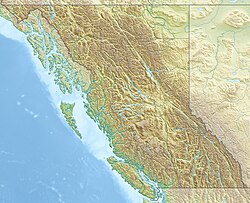Desolation Lava Field | |
|---|---|
 Williams Cone lava flow from the northeast | |
| Coordinates: 57°49′0″N 130°37′0″W / 57.81667°N 130.61667°W[1] | |
| Location | British Columbia, Canada[2] |
| Part of | Mount Edziza complex[2] |
| Age | Holocene[2] |
| Formed by | Volcanism[3] |
| Geology | Alkali basalt, hawaiite, picrite[2] |
| Area | |
| • Total | More than 150 km2 (58 sq mi)[4] |
| Elevation | 2,165 m (7,103 ft)[1] |
| Last eruption | Less than 2,000 years ago[5] |
| Designation | Mount Edziza Park[2][6] |
 Location in Mount Edziza Provincial Park Location in Mount Edziza Provincial Park | |
The Desolation Lava Field (DLF) is a volcanic field at Mount Edziza in British Columbia, Canada. It reaches an elevation of 2,165 metres (7,103 feet) on the Big Raven Plateau, but decreases to 820 m (2,690 ft) at Buckley Lake and 670 m (2,200 ft) in the Klastline River valley. The lava field covers more than 150 square kilometres (58 square miles) and contains 10 volcanic cones that range in elevation from nearly 2,135 to 1,430 m (7,005 to 4,692 ft). It is in Mount Edziza Provincial Park and is part of the Mount Edziza volcanic complex, the latter of which consists of several other volcanic landforms such as shield volcanoes, stratovolcanoes, lava domes and cinder cones. The Desolation Lava Field is the northernmost of two lava fields on the Big Raven Plateau, the other being the smaller Snowshoe Lava Field at the southern end of the plateau. Accessibility is only by aircraft or by a network of horse trails from surrounding roads.
Volcanism in the Desolation Lava Field began during the Holocene with the eruptions of Sleet Cone and Storm Cone, both of which issued lava flows. The Triplex Cones were formed by subsequent eruptions and issued lava flows more than 12 km (7.5 mi) long. Renewed volcanism created Sidas Cone and Twin Cone, both of which differ from other cones in the Desolation Lava Field in that they are structurally complex. The younger Moraine Cone produced a roughly 14 km (8.7 mi) long lava flow that temporarily dammed the Klastline River and Kakiddi Creek. Eve Cone and Williams Cone were produced by the latest eruptions in the Desolation Lava Field, the latter of which issued a 13 km (8.1 mi) long lava flow that temporarily dammed the Klastline River. Radiocarbon dating of charred alpine willow twigs preserved in ejecta from Williams Cone suggests the latest eruption in the Desolation Lava Field occurred in the last 2,000 years.
- ^ a b Global Volcanism Program: Edziza, Synonyms & Subfeatures.
- ^ a b c d e Souther 1988.
- ^ Souther 1992, pp. 26, 27.
- ^ Souther 1992, p. 213.
- ^ Souther 1992, pp. 223, 224.
- ^ Department of Energy, Mines and Resources 1989.
© MMXXIII Rich X Search. We shall prevail. All rights reserved. Rich X Search

